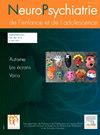« Un chat dans la gorge » : comprendre le langage figuré quand on est autiste
Q4 Medicine
Neuropsychiatrie de l''Enfance et de l''Adolescence
Pub Date : 2025-06-01
DOI:10.1016/j.neurenf.2025.03.002
引用次数: 0
Abstract
In the autism spectrum disorder, difficulties in understanding figurative language have been widely documented in the scientific literature. This review aims to examine the state of current knowledge by focusing specifically on the understanding of idiomatic expressions. Due to their semantic opacity and conventional nature, these expressions cannot be understood from the sole literal meaning of the words that compose them. This review explores the information processing strategies favored by autistic people to understand idioms and put them into perspective with the underlying cognitive mechanisms, including central coherence, executive functions and theory of mind. What should be retained from this synthesis is that the understanding of idiomatic expressions in individuals with autism relies on a complex interaction between their linguistic abilities and their capacity to integrate contextual information, a process influenced by their cognitive particularities. Finally, the interest of integrating these tasks into clinical assessments is discussed to refine the analysis of pragmatic skills and to propose educational and therapeutic interventions targeting the improvement of the use of context and inference strategies.
“猫在喉咙里”:自闭症患者如何理解手语
在自闭症谱系障碍中,理解比喻语言的困难在科学文献中得到了广泛的记录。这篇综述的目的是通过特别关注对习语表达的理解来检查当前的知识状态。由于它们的语义不透明和传统性质,这些表达不能从组成它们的单词的唯一字面意义来理解。本文从中心连贯、执行功能和心理理论等认知机制的角度探讨了自闭症患者理解习语的信息加工策略。从这个综合中应该保留的是,自闭症患者对习惯表达的理解依赖于他们的语言能力和他们整合上下文信息的能力之间的复杂相互作用,这是一个受他们认知特殊性影响的过程。最后,讨论了将这些任务整合到临床评估中的兴趣,以完善语用技能的分析,并提出针对改善上下文和推理策略使用的教育和治疗干预措施。
本文章由计算机程序翻译,如有差异,请以英文原文为准。
求助全文
约1分钟内获得全文
求助全文
来源期刊

Neuropsychiatrie de l''Enfance et de l''Adolescence
Medicine-Pediatrics, Perinatology and Child Health
CiteScore
0.60
自引率
0.00%
发文量
61
期刊介绍:
Organ of the Société française de psychiatrie de enfant et de adolescent, Neuropsychiatrie de enfance et de adolescence tackles all fields of child-adolescent psychiatry and offers a link between field and clinical work. As a reference and training tool for students and practitioners, the journal publishes original papers in child psychiatry as well as book reviews and conference reports. Each issue also offers a calendar of the main events dealing with the speciality.
 求助内容:
求助内容: 应助结果提醒方式:
应助结果提醒方式:


